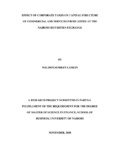| dc.contributor.author | Lemein, Weldon S | |
| dc.date.accessioned | 2019-02-28T06:56:38Z | |
| dc.date.available | 2019-02-28T06:56:38Z | |
| dc.date.issued | 2018 | |
| dc.identifier.uri | http://hdl.handle.net/11295/106429 | |
| dc.description.abstract | Each and every company would want a capital structure which is best fitted to a situation which simultaneously brings about the minimization of capital cost and maximization of the value of the firm. An optimal capital structure selection is at all times a critical matter for every company. Although, in practice, it is almost impossible to establish a capital structure which is perfectly optimal since several variables which some are conflicting, affect capital structure. This study sought to determine the effect of corporate taxes on capital structure of commercial and service firms listed at the NSE. The population for the study was all the 11 commercial and service companies listed at NSE. The independent variables for the study were corporate taxes as measured by effective tax rate, liquidity of a firm as measured by the current ratio, firm size as measured by natural logarithm of total assets and profitability as measured by return on equity. Capital structure was the dependent variable and was measured by long term debt divided by long term debt plus equity. Secondary data was collected for a period of 5 years (January 2013 to December 2017) on an annual basis. The study employed a descriptive cross-sectional research design and a multiple linear regression model was used to analyze the relationship between the variables. Statistical package for social sciences version 22 was used for data analysis purposes. The results of the study produced R-square value of 0.471 which means that about 47.1 percent of the variation in capital structure of listed commercial and service firms at the NSE can be explained by the four selected independent variables while 52.9 percent in the variation of capital structure was associated with other factors not covered in this research. The study also found that the independent variables had a strong correlation with capital structure (R=0.686). ANOVA results show that the F statistic was significant at 5% level with a p=0.000. Therefore, the model was fit to explain the selected variables relationship. The results further revealed that firm size produced positive and statistically significant values for this study while liquidity produced negative but statistically significant values. Corporate taxes and liquidity were found to be insignificant determiners of capital structure. The study recommends that when firms are setting their capital structure they should pay keen attention to their liquidity levels and their firm sizes as they significantly influence capital structure. | en_US |
| dc.language.iso | en | en_US |
| dc.publisher | University of Nairobi | en_US |
| dc.rights | Attribution-NonCommercial-NoDerivs 3.0 United States | * |
| dc.rights.uri | http://creativecommons.org/licenses/by-nc-nd/3.0/us/ | * |
| dc.subject | Effect Of Corporate Taxes | en_US |
| dc.title | Effect Of Corporate Taxes On Capital Structure Of Commercial And Services Firms Listed At The Nairobi Securities Exchange | en_US |
| dc.type | Thesis | en_US |



